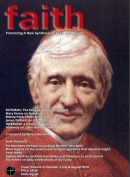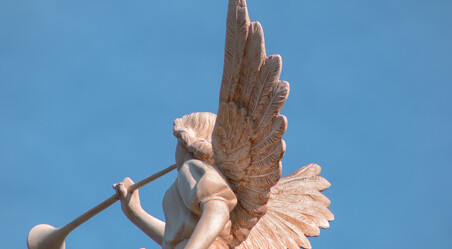Book Reviews
FAITH Magazine May – June 2012
Washed and Waiting - Reflections on Christian Faithfulness and Homosexuality
By Wesley Hill. Published by Zondervan, USA, 2010, 153pp, £9.99. Available from Amazon.
I have a hunch that this type of book is quite rare, because its subject matter is homosexuality and the struggle involved in "being gay" as well as embracing orthodox Christianity's teaching on the homosexual orientation. This struggle is portrayed in a uniquely intimate way -through the personal story of a young Christian (I presume Evangelical) man, who has made the very courageous decision to reveal his condition, struggles and insights to the wider public. The subject has assumed great importance in the western world, and is surely one of the major challenges which the Church must address, within the whole context of her teaching on human sexuality and gender. One senses among the general public, and among the thinking young especially, a shift of opinion regarding the issue ofabortion. However, the issue of sexuality, made concrete particularly in the question of same-sex marriage, is still dangerously confused. Wesley Hill's book will do much to increase people's understanding of how same-sex attraction affects a human being - surely a necessary pre-condition to addressing it and to providing assistance and hope. Indeed, I think that the provision of hope to others who suffer against their will from homosexual inclinations is one of Hill's primary aims in writing the book.
The book starts, interestingly, with some biographical material relating to Hill's dawning realisation of his homosexual orientation. He explains the title of the book, which refers to two quotes from St Paul - that we were washed when baptised, and are now waiting for the redemption of our bodies. Emphatically, this orientation was not one that Hill consciously chose, and it caused him much anxiety because of his strong Christian upbringing. He tried and was unsuccessful at forming heterosexual relationships, and with admirable courage finally sought help through friends, lecturers, pastors and counsellors. This provided a degree of relief, in that part of his anguish was that he could not be fully open with people about himself and his "secret", an aspect of thesuffering this disorder brings which is not often understood by others.
Hill provides an analysis of the biblical teaching on homosexuality and has a section on why the Church's teaching seems unpersuasive at first sight. This is an important point, for, while we have often taught what is wrong with homosexuality, why it is a disorder and that "gay sex" is always morally wrong - we have been less effective at proposing the whole, positive vision of sex and love, and also what paths to fulfilment are open to people who experience same-sex attraction. In a sort of "apologia" Hill then explains why he chooses to be faithful to Christian teaching and stay single. His theological meditation on the burden of the homosexual cross is insightful, if lacking a certain "magisterial clout" with which we are blessed in the Catholic Church. Nevertheless, he discerns thetruth that sex is not essential to human fulfilment - and that faithfulness to Christ is never a gamble; victory is assured. One senses, however, the great lack in Protestantism of a theology and spirituality of celibacy, so long established in both Catholicism and Eastern Orthodoxy.
In a second part, Hill relates what he learned from reading of Henri Nouwen's struggles with same-sex attraction, particularly the problem of loneliness. It struck me on reading this how woefully lacking in Britain are proper support and encouragement for those Catholics/ Christians who carry this cross, desiring to be faithful to Christ, notwithstanding small groups such as Encourage, which receive negligible financial and public support from the Church. I couldn't help thinking that some quotes from Benedict XVI would have contributed much to the book, especially on the nature of love. Part three gives some beautiful spiritual insights into what we might call the attempt to integrate a recognised homosexual condition into one's interior life. Here there is a good summary of thepain the disorder causes, which Hill has been trying to describe throughout the book, namely "the struggle to be faithful to the gospel's 'terrible decree' that we must hold in check our strongest urges and not engage in homosexual activity; the struggle to belong, to find the end of loneliness; and the struggle with shame, with nagging feelings of being constantly displeasing to God" (p.127).
To counter this awful feeling of being unacceptable to God, Hill shows how the New Testament in no way supports a negative self-conception. And, as with all burdens and crosses in this life, they must be looked at with "Resurrection glasses" on, for these trials prepare us for a weight of future glory out of all proportion to them. Hill has come to see how his struggles are not separate from God's providence for him - they do not disqualify him from living the Christian life and being pleasing to God, but are rather "part and parcel of what it means to live by faith in a world that is fallen and scarred by sin and death".
Fr Stephen Brown
Bradford
The Spirit of Celibacy
By Johann Adam Mohler, translated by Cyprian Blamires. Hillenbrand Books, distributed by Gracewing, October 2007, 196pp, £15.99.
As a third-year seminarian, it's been a joy to start my theology studies proper this year. One of the highlights is ecclesiology. The last 200 years has seen great scholarly study regarding the life and nature of the Church, culminating in particular in the documents Mystici Corporis and the Vatican II constitution Lumen Gentium. It is in my studies in this area that I first encountered the name Johann Adam Mohler. As a theologian at the University of Tubingen in the first half of the 19th century, Mohler played an important role in Romanticism and encouraged a rediscovery of patristic thought. This contributed towards the Church's deeper understanding of her own mystery and particularly to the development of the theology of the Mystical Body through theologians likeHenri de Lubac and Pope Pius XII. This knowledge left me excited at the prospect of reading his work, and I was not disappointed.
His essay on celibacy was written in 1828 in response to a petition called the Denkschrift, which was produced in Baden, Germany, and called for an end to priestly celibacy. It argued that celibacy was outdated and unsuitable for contemporary Germany using a variety of theological and social arguments that were poorly conceived and constructed. Mohler's riposte to this petition is well argued and forthright. He dismisses the arguments with ease through his outstanding knowledge of scripture and the early Church, while offering the reader a vision of priestly celibacy that is both refreshing and exciting.
The clergy in Baden, at the time, appear to have been in a state of some turmoil. They were unspiritual, worldly unmotivated and few in number; and the writers of the Denkschrift lament that if only celibacy were removed, priests' spirits would be reignited and more men would put themselves forward for the sacred ministry. Moreover, they claim that celibacy was never really essential to being a priest but was a later addition imposed by the Church. Surely, the letters of Paul show that men were called who were married (1 Tim 3:2). It all sounds a little familiar, doesn't it? It is remarkable that the arguments put forward almost 200 years ago still resonate today. The re-printing of this book is therefore very timely.
Mohler responds to these arguments in very clear language: "Do they really believe that wives can give priests what they lack?" (p4). He is concerned that the authors of the Denkschrift too easily give in to the Zeitgeist of German society at the expense of what is precious to the Church. The Church always proclaims the spiritual dimension of humanity because ultimately it must be oriented to God. It is from this perspective that Mohler condemns the unspiritual motive of his opponents. He writes, for example: "The fact that our author can persistently talk about sacrifice as if it meant a joyless, unwilling and hesitant gift shows that not even the faintest spark of religious inspiration can have glowed in his heart" (p26). Indeed, for Mohler, anyone who attacks celibacy isreally betraying a deeper discomfort with the Church: "Failure to comprehend the Gospel and failure to understand the Church and her history always go hand in hand" (p11).
His understanding of celibacy's intrinsic value to the priesthood, however, is the real treasure of this work. He expounds a vision that reaches for the ideal that draws people out of themselves towards God and the life of holiness. If this life is lived with authenticity and commitment he foresees no shortage of priests from all levels of society but particularly from the young. If this positive view of celibacy is conveyed, "then we shall see the most distinguished among the younger generation fired up with the inspiration to feed the flock of God... and their deep hearts will grasp the whole idea of the Church and accept it into themselves as a living power" (p73). The reader will find that Mohler writes with this powerful conviction throughout the essay.
The book ends with a commentary on the essay that helps to understand some of the wider context. Much of Mohler's argument, however, is regurgitated in this section and little is added to the strong defence already made. Nevertheless the editor offers us his reasons for reproducing a book that was little known in its own day. His conviction that Mohler's arguments are just as poignant and compelling today as they would have been then is shared by this reader. The book not only offers a comprehensive argument defending priestly celibacy that answers many of the objections found today, it also acts as an excellent introduction to an important 19th-century theologian whose rediscovery can only be positive.
Philip Cunnah
Oscott
Newman the Priest, a Father of Souls
By Gerard Skinner. Gracewing 2010, 299pp, £12.99.
Blessed John Henry Newman has been a great gift to his biographers: he lived a long life and left a large literary legacy. Fr Skinner has trawled through Newman's life using his books, his sermons and contemporary reminiscences. Bouyer, Blehl and Zeno have given us the spiritual view; Walgrave the theological angle; Culler and Coulson the didactic. Skinner leans heavily on Zeno to examine John Henry Newman from the perspective of his priesthood.
When you think you know just about all there is to know about Newman, you find that there is always something more to be discovered. So it is that Fr Skinner unearths those insights into Newman which emerge from the hidden depths. For instance I didn't know that he wrote sermonets when he was 16, and that when he was 23 he found preaching "rather a drain upon my head".
Those who persist in seeing the future cardinal as melancholy (and the picture of Newman on the cover does not help) will be pleased to learn that he founded a dinner club as vicar of St Mary's in 1828, which met once a fortnight.
There was always a serious side to Newman. He told Dean Church that the famous Richmond portrait lacked something because the artist "could not draw [him] out". But here was someone who would spend three to four hours saying the breviary, who counselled an element of mortification in one's life, and who relentlessly examined his own thoughts and actions in the light of God's truth.
Fr Skinner considers that Tract 90 brought things to a head but I would have liked mention made of the influence on Newman of the Jerusalem bishopric, which was, in a way, as crucial as the Gorham judgment was for Manning. It is also strange that he quotes the letter to his curate, Bloxam, in 1841 on the conversion of England by missionaries going barefoot and being pelted and trampled on, and does not make the connection with Blessed Dominic Barberi.
But these are minor quibbles. Newman's ministry as a priest was not seen as a profession but as an apostolate. When he was a fellow of Oriel he would combine St Mary's with the bursary and his tutorship. As superior of the Oratory, he would oversee Smethwick, Harborne, the new workhouse, the ragged school, the Oratory school, his writings, his help for the poor, and his daily community practices, which included waiting at table, hearing confessions, baptising and marrying. Newman's affectionate side is also illustrated. He writes with feeling to a parent of the school, "I often think what poor creatures we priests are, who, like gentlemen of England, sit at home at ease, while you, married men, have all the merit of anxiety and toil which the care of a family involves. Your stateis in fact one of 'perfection', when compared with ours, and there is a day in prospect when the first shall be last and the last first."
The same Hungerford Pollen was the architect for the University Church in Stephen's Green, Dublin (and its professor of Fine Arts). The Church of Our Lady Seat of Wisdom was built mainly from the fund raised as a result of the Achilli trial. It is a fine demonstration of Newman the priest's views on ecclesiastical architecture: "the beauty of Greece with something of the wildness of other style yet without the extravagance of the moor or the gloom of the Gothic". It enjoys an enduring reputation as a setting for the marriage of Irish graduates.
Newman's devotion to Our Lady is often overlooked. Fr Skinner mentions the incident recorded by Newman about a Protestant visitor to a Catholic friend who was dying. The visitor said that nobody, even as holy as Mary, should be allowed to come between the soul and God, leading her to forget him. The Catholic replied that she could hardly forget him as she had only just received him from the priest.
As a sort of appendix Fr Skinner includes seven complete sermons, four from Parochial and Plain Sermons and three preached as a Catholic.
Fr Skinner is to be thanked for his industry, giving us new insights into the life of one who made such an impact on the people of Birmingham alone that 20,000 attended his funeral cortege. His influence on the wider world is, of course, incalculable.
Fr James Tolhurst
Chislehurst
Sunday and Feast Day Sermons
By Rev Robert Letellier, St Paul's US, paperback, 270pp, £9.99.
At first I thought I shouldn't be the person reviewing this book, as it's clearly meant for priests. It's a readable, practical handbook with sermon ideas for all the Sundays and principal feast days of the Church's year, following all three cycles of the Scripture readings. As a laywoman, I could quickly set it aside as being not-in-my-department.
But sermons, although delivered by the clergy, are aimed at the laity, so I dipped in. And it's good - very good. The suggested sermons are packed with interesting titbits of information, supportive of faith, easily digested and very nourishing. This would be an extraordinarily useful addition to the desk of any busy priest. In fact, I'll go further - fathers, do please get this book, because your parishioners will benefit, and you will be able to take the credit for doing good work.
A sample: for the feast of Corpus Christi, we are given some practical grounding in Christ's words about being the "living bread come down from heaven", together with thoughts about how we are united to the Father through Jesus, and also with one another - quoting St Paul - and finally a profound look towards eternity as "Jesus' gift of himself is transmitted to us beyond time and space". It's rich, inspiring, drawn from the Scriptures, and something that we can all grasp and think about.
Another example, taken at random: for the Third Sunday after Easter, with a sermon on Acts 5: 27-32 and 40-41 we get a strong and vivid picture of the Apostles who are now ready to go out into the world and take the Gospel everywhere. We learn that the word "martyr" means "witness" and that "apostle" means "one who is sent" and then grasp what this really meant in the lives of the Apostles, and indeed what it means today: "Faith and love in Jesus will issue forth in ministry. 'Witness' means being sent, and being sent may well mean giving your life for Jesus..."
We need good sermons. It would be excellent to think that this book could help to dispel that dreadful waffle that replaces a homily and too often begins: "Urn...I was just thinking this morning, on my way here..." thus indicating that no real preparation has been done at all.
I found this book a helpful and inspirational read. In fact, I found myself looking ahead to the next couple of Sundays and thinking about the readings I'd hear at Mass and the messages that had been drawn from them.
This book would make a good ordination gift, and copies should be available at seminaries; it should find a place in retreat centres and religious houses. It might look a bit too pointed to give one to your parish priest, but he'd probably appreciate it. And this laywoman really enjoyed reading it, and has been inspired and helped by it - not something I thought I would ever say about a book of sermons.
Joanna Bogle
New Maiden, Surrey
Fatima for Today: The Urgent Marian Message of Hope
By Fr Andrew Apostoli, CFR. Foreword by Cardinal Raymond Burke. Ignatius Press, USA (February 2011), distributed by Gracewing, £14.99
The Fatima conspiracy theorists will loathe this book. It is a well-written and well-researched account of the events that began outside a small village in Portugal in 1917 and that continue to have strong repercussions today. It carries a foreword by the Prefect of the Supreme Tribunal of the Apostolic Signatura. It demolishes the notion - put about widely at present and assisted by the internet - that successive popes have lied to us about the visions of Fatima and especially about the famous "third secret". It calls us all to prayer and has a simple and humble message - very irritating to those who prefer apocalyptic predictions, plots and indignation.
Three children experienced a series of extraordinary visions in 1917 and were given a message that was both extraordinary and very ordinary: people must pray and do penance (that was the ordinary bit; these things are central to Catholic life, always have been and always must be) and failure to do this would ensure that evils would be spread by Russia across the world (an extraordinary statement to make to children living in an obscure corner of Portugal with limited access to any knowledge of Russia or indeed to anywhere else outside their local area).
The place where the visions occurred was the "Cova da Iris", or "Cove of peace". In 1917 Europe was at war. Portugal had been spared the slaughter, and when the Fatima visions occurred the three young children were spending a peaceful day as they had done many times before, taking care of their families' livestock, eating a snack lunch and playing together in the sunshine.
They prayed together as a matter of course - all came from devout and practising Catholic families. They were by modern standards poor and by any standards good, hard-working, honest and truthful children.
The children's accounts of the visions were consistent and they did not flinch under considerable pressure from their families and others, and even under some rather brutal treatment by the local authorities. They understood that Mary had come from Heaven to call people to penance and they took this very seriously, undergoing much physical discomfort with fasting and sacrifices. Two of the children later died in the influenza epidemic of 1919/20 and the third, Lucia, lived on to a great age as a Carmelite nun, dying in 2005.
Mary had told the children that the Pope must consecrate Russia to her, and this was done in 1984 by Pope John Paul II, the Pope from Poland whose life was so extraordinarily bound up with the Fatima message. In a vision, the children saw a pope shot and falling to the ground before a great crowd. On 13 May 1981, the anniversary of the Fatima visions, John Paul was shot and fell before a great crowd in St Peter's Square. The shot should have been fatal, but the Pope did not die. As he would later express it: "One hand fired the bullet - another guided it." He had not known of the children's vision - it formed part of the "third secret", which had not then been revealed. He asked for the secret to be retrieved from the Vatican archives, read it, and saw its significance. He would laterplace the bullet in the crown of the statue of Our Lady at Fatima, and release the secret -accompanied by a detailed commentary by Cardinal Joseph Ratzinger, then Prefect of the Congregation for the Doctrine of the Faith.
But if you trawl the internet for "Fatima" you will not get much of this - instead you will get a great muddle of conspiracy theories, assertions of papal duplicity, affirmations that the Consecration of Russia was not done properly, that the published secret is a fraud, and much more. Which is why it is useful to have a book which sets things out in their chronological order, and in a spirit of faithfulness to what occurred and loyalty to the Church to which the young Fatima visionaries entrusted all that they had seen and heard.
Pope John Paul did consecrate the world, including Russia, to Mary in 1984; and five years later the Russian atheistic empire, which had caused so much misery and under which some nations had been crushed and virtually annihilated, crumbled and was gone. Prayer and penance are still needed and always will be. Popes will continue to suffer and be shot at, literally and metaphorically, and much of their sufferings will come from within the Church. Paul VI was vilified by people claiming to be deeply loyal Catholics, and continues to be after his death. Blessed John Paul not only suffered in the 1981 assassination attempt but endured several serious illnesses and operations. He was loathed by some of the traditionalist "Fatimist" campaigners - one tried to stab him in May 1982 at Fatima -and some lobbied angrily against his beatification. On a pilgrimage to Fatima, Pope Benedict XVI spoke movingly about the continuing role of suffering in the life of the Church and thus of the Pope.
Fr Apostoli's book is a wake-up call to the reality of the one of the great Marian visions of modern times. The Christian life is a journey with God - we are aiming at Heaven. Our sins will be what prevent us from getting there, and they will also wreak havoc and misery while we are on earth. The Church has taken to heart the message of Fatima and recognises that it still has so much to say to us all. Fr Apostoli notes, for instance, the link with Islam (Fatima is the name of a major female figure in Islam: Muslims pay great honour to Mary, and the Fatima statue has proved to be a source of devotion when taken to Islamic groups). The saga that began in 1917 and continued through the huge events of the 20th century up to the beatification of a pope in the 21st is not over yet. This bookwill help us to understand it all much better.
Joanna Bogle
New Maiden, Surrey






